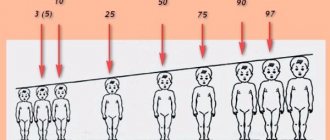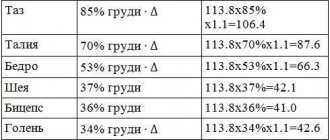In the sixth year of life, a redistribution of muscle and fat tissue occurs in a person. The former are becoming more numerous, the latter are leaving. Therefore, now every year the child will look more and more like an awkward teenager. At this age, children develop posture, which parents should pay close attention to. Over the past year, the baby has grown by 5–7 cm and gained 2–3 kg. This ended another age-related growth spurt. Then, until adolescence, the child will grow more slowly. What is the height and weight of a child at 6 years old? How do they change throughout the year? What does this depend on? What should you pay attention to?
What to focus on?
Approximate guidelines for the anthropometric development of 6-year-old children can be found in special centile tables. It should be remembered that they provide only the most average indicators.
At 6 years old, the child's growth is quite moderate. Girls are usually slightly shorter than boys (1–3 cm), but their weight may be slightly higher (1–1.5 kg). The hereditary factor should not be discounted. Children with short stature will be slightly behind the norm, while children with tall parents will be ahead of their peers.
If your baby is active and healthy, don't worry until his weight falls below the lower limit on the chart. Conversely, if a child weighs as much as indicated in the average values, but unhealthy thinness or lethargy is obvious, you should be wary and visit a doctor.
On average, during the sixth year, a baby can grow by 1–4 cm and gain 1–2.5 kg. Lagging or significant advance in height or weight can be caused by various factors, such as:
- heredity;
- nutrition;
- parasites;
- stressful situation;
- low hemoglobin;
- endocrine or neurological disorders.
You should pay attention to this and consult with specialists in a timely manner - they will find out why the height or weight of a child at 6 years old does not fit into the normal range.
How do girls and boys grow from 5 to 10 years old?
Starting from the age of 5, the child’s body gradually transforms into a teenage one. The height and weight standards for children aged 10 years, as well as during the primary school period, are:
- 6 years - the body becomes 6-7 cm taller and 2.5-3 kg heavier, average height is 107-121 cm, weight 18-28 kg, chest circumference 56-65 cm;
- 7 years - another 8-10 cm are added in height, 2.5-3 cm to the chest, body length is 114-128 cm, the baby weighs 20-30 kg;
- 8 years - changes characteristic of puberty are not yet noticeable, 21-32 kg and 119-134 cm;
- 9 years - children grow to 125-140 cm and 24-36 kg, respectively;
- 10 years - averages - 129-146 cm and 25-39 kg.
For a simpler understanding of child development, here is a table of the height and weight of children 10 years old:
How much should girls weigh at 11 years old? Caring parents who are concerned about the health of their child should know the answer to this question. For each age category, there are certain standards that exclude thinness or obesity.
At what boundaries should the scale arrows stop? A detailed answer to this question can be found in this article.
- Main settings
- What to do if a growth disorder is detected?
- The dangers of being overweight
- How to fix this problem?
- The dangers of being too thin
- Recommendations
- Conclusion
Basic anthropometric indicators
You can compare the main anthropometric standards using the following tables.
What can parents do?
The most common cause of short stature and low weight (or, conversely, too much weight) is still poor nutrition: lack of vitamins, addiction to unhealthy foods and sweets to the detriment of fruits and vegetables, as well as low physical activity.
The following rules will help the timely growth and development of a preschooler.
- Do not reward your child for good behavior or success with sweets. In addition to a bad habit, this will also lead to a consumerist attitude towards parents.
- Don't force you to finish everything on your plate. Children feel full. And food violence will only cause persistent protest.
- Do not completely exclude sweets from your children's diet. The prohibition gives rise to the desire to secretly do something out of spite.
- Encourage your child to be physically active: helping around the house, playing in the yard, and a sports section will help him spend the calories he receives wisely and work up an appetite.
- Limit the time your child spends playing computer games or watching TV. This reduces motor activity and also has a negative effect on the nervous system.
- Don't let your child eat in front of the TV or computer. This way he can absorb much more than he needs. In addition, such food is not always healthy.
- Try to create a balanced, varied menu and follow a diet (eat at approximately the same time).
That, in fact, is all about the physical indicators of a six-year-old child. When comparing them with norms, it is worth exercising prudence: taking into account genetic characteristics, gender, and other factors. If you have doubts, it is better to dispel them with your doctor. Or solve the problem in a timely manner if it is identified.
Girls, tell me how much your child weighs at 6 years old. We weighed the children in the garden in the fall, our weight was 18 kg, and yesterday I came and posted lists with the weight of the children, in the spring we already have 22 kg. The child gained 4 kg in six months, isn’t that a lot? Visually the weight is normal, but I am worried about such a rapid weight gain, even for me 4 kg in half a year is a lot, but for a child? Or is it supposed to be that children gain weight in the winter and height in the summer?
- Is this the norm?
- How many centimeters does a newborn grow?
- Low weight, what to do?
- The child is growing very quickly
- The child is not gaining weight
What does weight depend on?
It depends on many factors, for example:
- Heredity. If your baby has thin parents, his body type will most likely be the same;
- Nutritional features. A baby whose nutrition is properly organized grows well and gains weight, and does not suffer from excess weight;
- Work of the endocrine system. Children suffering from endocrine diseases, such as diabetes mellitus or thyroid diseases, often have a weight higher or, conversely, lower than normal;
- Level of physical activity. A child who attends sports clubs and plays active games in the fresh air every day rarely has problems with obesity.
Answers
- On site 2
- Via VKontakte
Hello!
To publish posts and get full access to the project's features, log in or register.
If the child looks proportionate and there is no significant excess weight, then everything is fine. It is normal for children to gain weight over the winter. When else do they gain weight? Perhaps in the summer, when they run around the street all day long. My daughter is 5 and a half years old. She is not recovering so quickly, on the contrary, very, very slowly. But sometimes I’m shocked by the speed of growth and don’t have time to update my wardrobe. This is all very individual and should not cause concern.
I have the opposite situation; my 6-year-old daughter weighs 12.5 kilos. And at the same time absolutely healthy. But the view. Auschwitz is resting. Your child weighs normally.
Physical development of a child at 6 years old
Let us name the main points characterizing the normal physical maturation of six-year-old children:
- the replacement of milk teeth with permanent ones begins;
- abdominal breathing is replaced by chest breathing, the diaphragm is strengthened;
- the musculoskeletal system, including the spine, is actively developing;
- the number of respiratory movements per minute (about 20-25) is close to the adult norm;
- the lungs mature;
- the size of the heart increases as this is required by a rapidly growing organism;
- heart rate changes (up to 85-100 beats per minute) and blood pressure;
- the immune system is actively functioning;
- the nervous system is strengthened, the baby better tolerates increased emotional, physical, psychological and intellectual stress;
- Speech improves, vocabulary expands, pronunciation defects disappear.
How much does a child grow in the 6th year?
According to WHO, the average height of six-year-olds increases to 116 cm, with the acceptable range being from 110.1 cm to 120.8 cm.
Like other indicators, the height of girls is slightly less than that of boys, and by the age of 6 the average height should be 115.1 cm (an acceptable range of values is from 110.1 cm to 120.1 cm). Boys grow up to 116 cm, with normal limits ranging from 111.1 cm to 120.8 cm. If your baby differs significantly in height from the average values, do not delay a visit to the doctor. Perhaps these are the individual characteristics of the child, or perhaps the first signs of disorders in the body.
Main settings
There is a standard height-to-weight chart for children. It contains important information.
- Any weight up to 25 kilograms indicates underweight. Doctors consider this indicator a critical point when you immediately need to seek help from a specialist.
- From 25 to 30 kilograms weight below average. There is no threat to health, but it is still recommended to adjust your diet and add strength training.
- From 30 to 39 kilograms is absolutely normal weight. With such boundaries, the child feels absolutely comfortable and can live a full life. You should continue to monitor them.
- From 39 to 45 kilograms – above average weight. The parent can independently eliminate harmful foods from the girl’s diet and walk with her more.
- If a teenager weighs more than 45 kilograms, then we are talking about obesity. There is a direct threat to his health. You should seek help from a nutritionist and undergo appropriate examinations.
It is important to take into account not only the age, but also the height of the girl at 11 years old. The average ranges from 136 to 153 cm. If it is higher or lower than this limit, then the weight norm may change.
Child's head circumference at 6 years old
The head size of a six-year-old child normally ranges from 50.4 cm to 52.7 cm. At the same time, according to WHO tables, the average value for boys is 51.9 cm (acceptable limits are from 51.1 cm to 52.7 cm), for girls - 51.2 cm (normal limits - from 50.4 cm to 51.9 cm). To ensure that the result of head circumference measurements is correct, it is better to use a soft centimeter tape. Place it on the most protruding part of the back of the head, while making sure that in front the tape runs along the brow ridges and is not pulled too tightly.
Foot size for a boy and girl at 6 years old
By the age of six, boys' legs begin to grow faster than girls'. Typically, a six-year-old girl's shoe size is approximately 28-28.5, which corresponds to a foot length of 17.5-18 cm. A boy's foot is slightly larger - 18.5-19 cm in length (size 29-30). To quickly and easily find suitable shoes in the store, use the table of shoe sizes for a child aged 6 years:
Before purchasing, it is important to correctly determine the length of your child’s legs. Take measurements in the evening - by the end of the day, blood flows to the limbs, and the size of the leg increases. In addition, it is wise to put on socks first - after all, the shoes will not be worn on bare feet. Foot length is measured using a piece of paper, a pencil and a ruler. Place the child flat on the sheet and trace his foot along the contour. Using a ruler, find out the distance from the heel to the end of the big toe - these are the most distant points on the foot. Round the result up and remember. When choosing shoes for your baby, tell the seller this number, and he will choose the right size for you.
Age characteristics
It happens that we do not always notice the age-related changes in our child. However, the baby grows not only externally, but also internally - he becomes more conscious, organized, and asks many questions, including about gender differences in people. The age characteristics of children at the age of 6 are such that they often strive to attract attention to themselves, especially if there are younger children in the family. This speaks to their need for love, acceptance and self-expression. The desire to communicate with peers is clearly expressed, but one’s own “wants” often take precedence, and the child constantly tests the strength of the boundaries of what is permitted in society and the family. This is how children learn to understand what is certainly possible and what is prohibited, and also learn the norms of behavior in society. By the age of six, children already cope well with their mood and emotions, strive for independence, but, at the same time, are very attentive to the behavior of others and are prone to imitation. They still find it difficult to keep their attention on one topic for a long time, especially if it is not interesting to them. Therefore, it is very important not to forget to conduct training in the form of a game and first intrigue the baby.
Nutrition at 10 months
There are also standards for the daily amount of food consumed for children of different ages. At ten months, a boy or girl should eat a volume of food equal to 1/8 or 1/9 of his body weight.
Maybe mommy continued breastfeeding until this age. This is good even if there is only one feeding left per day.
At ten months, children can sit at a common dining table with mom and dad, master a spoon and eat their own dishes. Up to 10 months, children should be familiar with vegetables, cereals, yolk, fish, fruit puree and cottage cheese. As for liquids, in addition to water and juices, the child should be introduced to compotes, rosehip decoction, and fruit drinks. They are needed for variety and normal digestion.
Mothers of children of this age already know their taste preferences. They notice that children love some vegetables more, while others even try to spit them out. Over time, preferences may change, but for now they need to be taken into account and not force the child to finish eating something he doesn’t like.
Psychology of a six year old child
The psychological characteristics of 6-year-old children are associated with different areas of their development:
- awareness of one’s own personality, gender, place in the family;
- possession of an extensive vocabulary reaching up to 7 thousand words;
- getting rid of speech defects and can construct sentences grammatically correctly;
- the predominance of visual-figurative thinking, logical thinking is in the process of formation;
- increasing memory capacity;
- the child learns to compare, generalize, classify;
- mastering time;
- understanding of norms, rules of behavior and decency;
- desire for imitation and self-expression.
Parents simply need to be interested in the psychological side of their children’s lives. Even a little knowledge in psychology will help you better understand your six-year-old child. Speaking about the differences in the psychology of boys and girls of six years old, it is worth saying that girls are distinguished by a large amount of memory and its stability, and show greater neatness and accuracy. We have already mentioned that at this age children pay attention to gender, and, as a result, begin to make friends with people like themselves. When choosing a friend, future men value courage, strength, and ingenuity, and little ladies value beauty, responsiveness, and gentleness. For boys, the figure of the father comes to the fore, who gives the correct social guidelines and teaches his son about masculine activities. Daughters, on the contrary, gravitate towards their mother, show femininity and do women’s chores with interest, helping their mother around the house. Therefore, it is extremely important during this transition period to give your grown-up kids the right values and attitudes that they will carry throughout their lives.
About overweight and underweight
So, the above standards are indicative. And many children at 10 months exceed the weight indicated above. If this is 6-7% above the norm, then this is quite acceptable. But when too much or too little is 12-14%, then these are the first alarm signals. When the deviation from the norm reaches 25% or more, the child needs diet correction.
Practice shows that in most cases, children who grew up on artificial feeding are prone to overdosing. A significant risk factor is a genetic tendency to gain weight. This tendency can appear from a very early age, and it is noticeable visually. In this case, the mother should not let the situation take its course. It is necessary to cut down the baby’s daily diet and force him to move more. Exercises with a baby who is prone to obesity should be done twice a day, and you should give him plenty of water to drink. There is no need for such a baby to add butter or vegetable oil to its complementary foods. Offer porridge once a day, and only in the morning. At this age, you can already switch to four meals a day.
By and large, it is always better to underfeed a child rather than vice versa. Popular pediatrician Evgeny Komarovsky thinks so. He is confident that underweight is not as dangerous as overweight. And when children, while falling behind age norms, are active, playful, curious, sleep well, and their hemoglobin is normal, then parents have nothing to worry about. Sometimes the same genetics plays a role. If the baby’s mom or dad is miniature and short, then who will the child be like? You can make his diet more filling, replace vegetables with porridge, and take more walks before meals. Perhaps the shortage is due to the fact that the child is just too active and energetic? Then parents also have no reason to worry.










